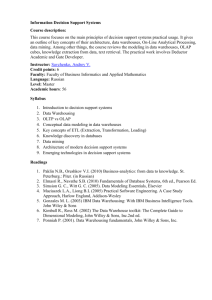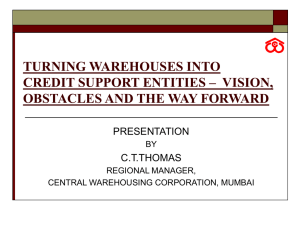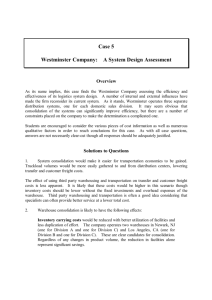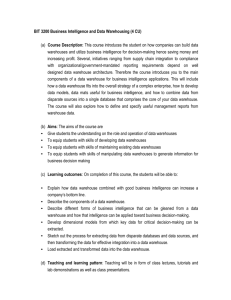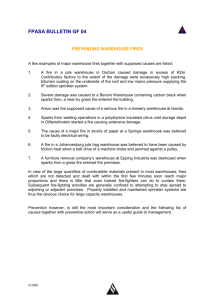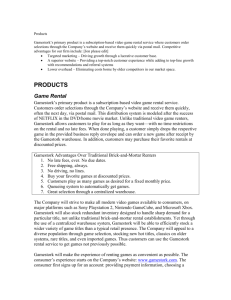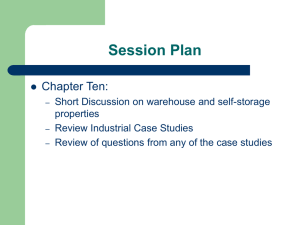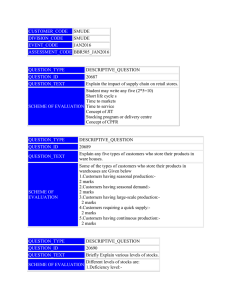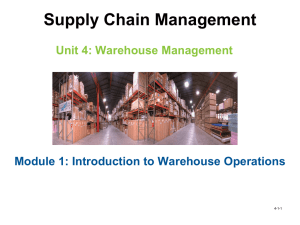Air Carriers
advertisement
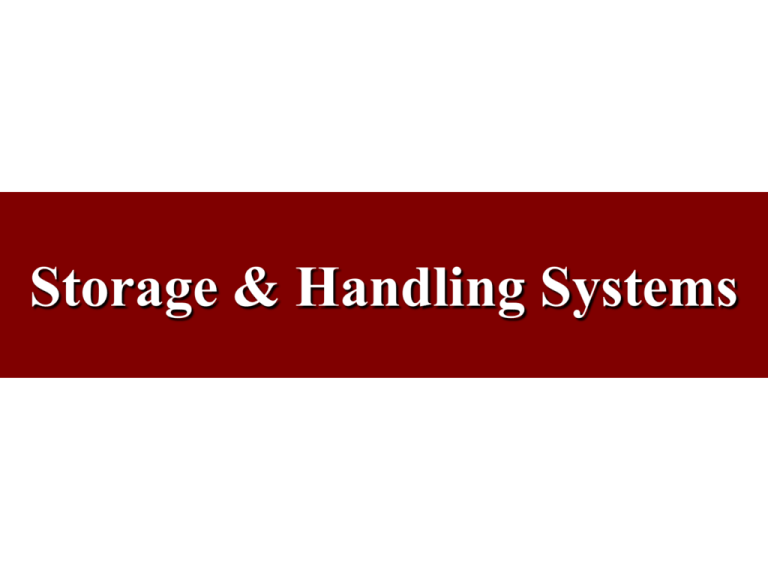
Storage & Handling Systems Reasons for Storage • • • • Reduce transportation – production costs Coordinate supply and demand Assist in the production process Assist in the marketing process Storage System Functions • • • • Holding Consolidation Break-bulk Mixing Consolidation Warehouse Manufacturer A 10,000 lbs. 10,000 lbs. Manufacturer B 40,000 lbs. 10,000 lbs. Consolidation Warehouse Manufacturer C 10,000 lbs. Manufacturer D Retailer Break-bulk Warehouse LTL Low rate TL shipment Customer A LTL Manufacturer Distribution Warehouse Customer B LTL Customer C Distribution Warehouse used for Product Mixing Product A Manufacturer A Products A, B, & C Customer X Product B Manufacturer B Distribution Warehouse Product C Products A, B, & C Manufacturer C Customer Y Materials-Handling Functions • • • Loading & Unloading Movement to and from storage Order filling Storage Alternatives • • • • Space Ownership Rented Space Leased Space Storage in Transit Advantages of Space Ownership • • • • • • Less expensive warehousing than renting or leasing (especially if have high utilization of the space) Higher degree of control over warehousing operations May be only practical alternative if products require specialized personnel or equipment (i.e., pharmaceuticals) Benefits from real estate ownership May use space for other purposes in the future Space may serve as base for sales office, private fleet, or purchasing department Renting Space in Public Warehouses • 6 most common types of Public Warehouses – Commodity warehouses • – Bulk storage warehouses • – Limit services to storage & handling of commodities that spoil easily (lumber, cotton, tobacco, grain, etc.) Store & handle bulk products (i.e., liquid chemicals, oil, syrups, etc.). Also mix products & break-bulk as part of their service) Temperature-controlled warehouses • Regulate temperature & humidity in the storage space. Renting Space in Public Warehouses • 6 most common types of Public Warehouses – Household goods warehouses • – General merchandise warehouses • – Specialize in storage & handling of household items and furniture. Most common type. Store merchandise that does not require special facilities or special handling Miniwarehouses • Small warehouses having unit space from 20 to 200 square feet. Often grouped in clusters. Intended as extra space – hence, few services provided. Advantages of Public Warehouses • • • No fixed investment Lower cost if utilization of private space would be low Location flexibility Leased Space • • • • Intermediate choice between short-term space rental in public warehouse and long-term commitment of private warehousing. Typically can achieve lower rate in leasing than in renting the space Lose some location flexibility since lease contract will be for specified period of time Leasing might offer the opportunity to have control over the storage space Storage in Transit • • • • Refers to the time that the goods remain in the transportation equipment during delivery Requires coordination between owner of the goods and provider of the transportation service May reduce or even eliminate the need for conventional warehousing Attractive to firms dealing in seasonal merchandise or shipments over long distances Materials-Handling Considerations • Load Unitization – – • Palletization Containerization Space Layout – – • Storage Order picking Storage Equipment Choice – • Racks, shelf boxes, bins, Uframes Movement Equipment Choice – – – Manual equipment Power-assisted equipment Fully-mechanized equipment
